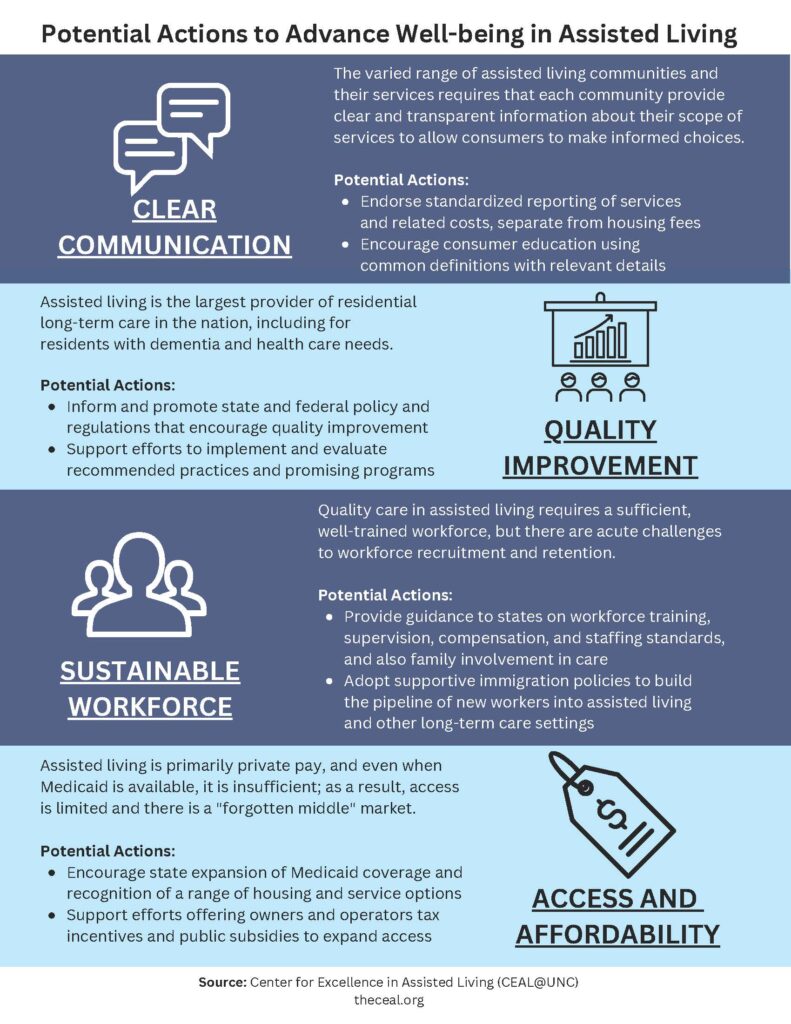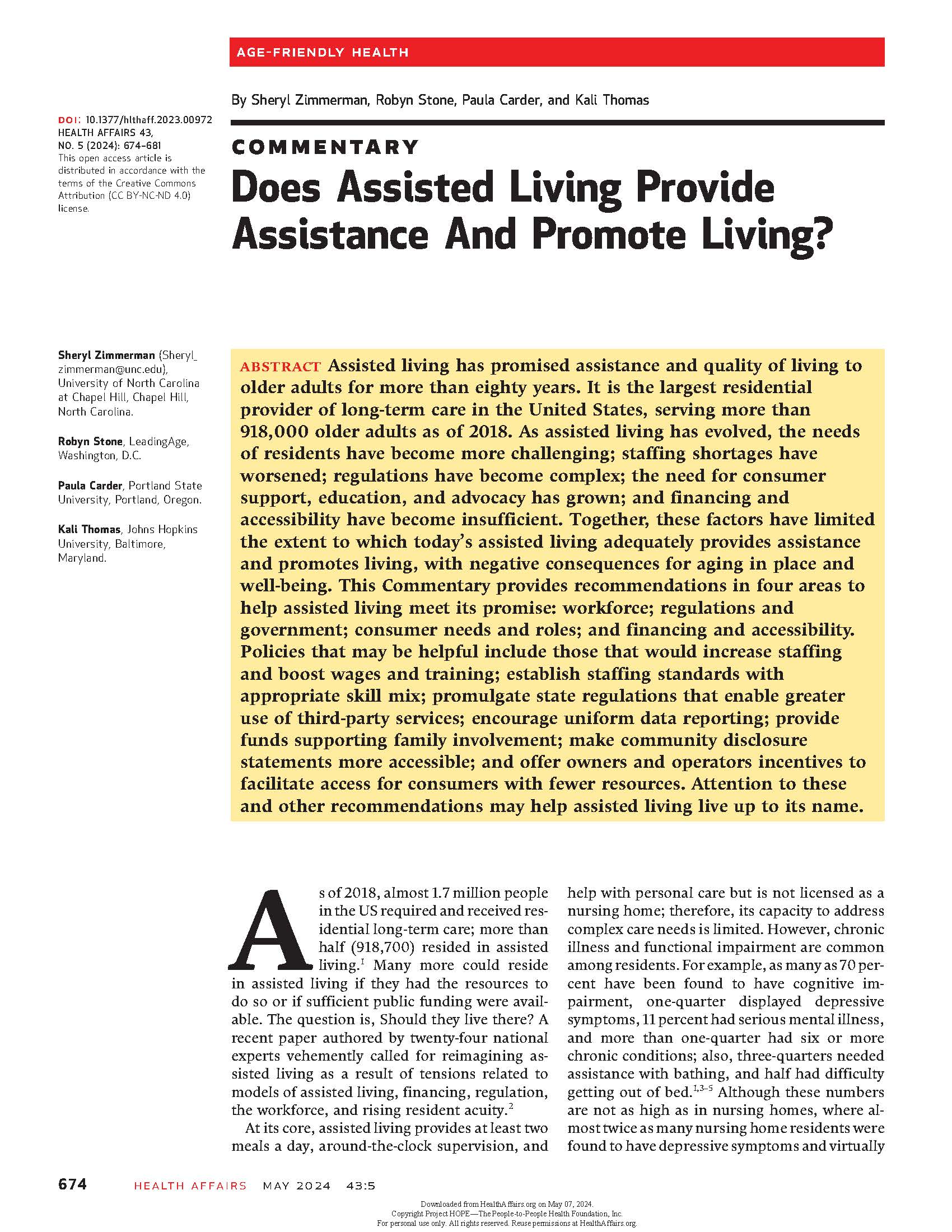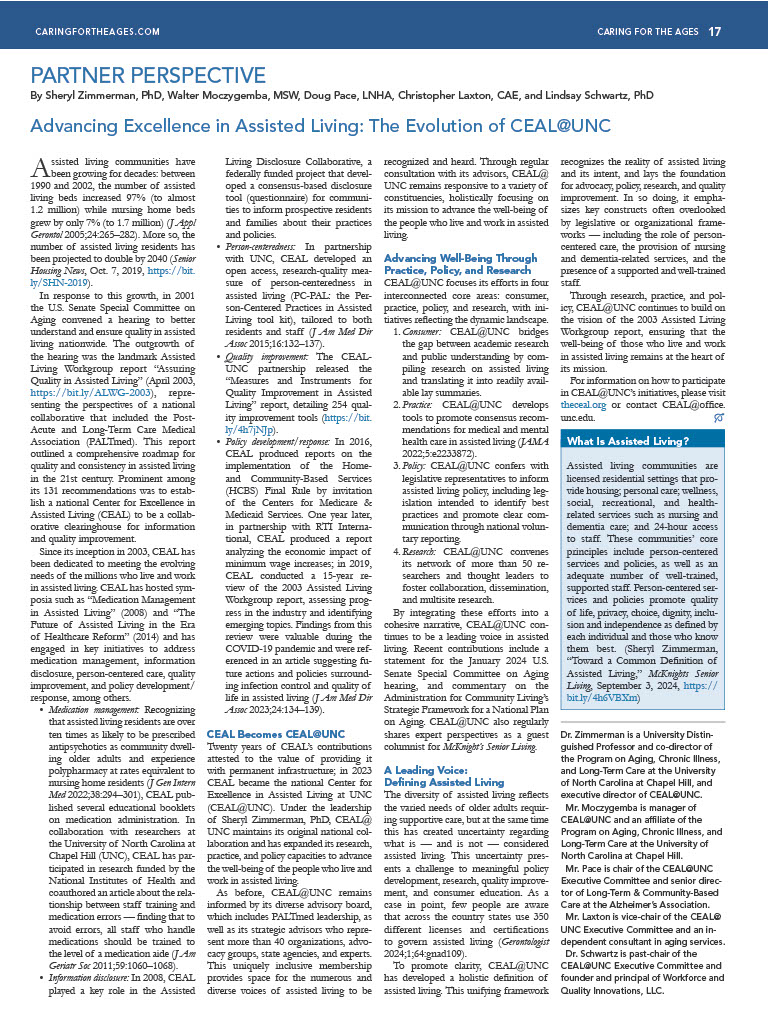
Quality Improvement
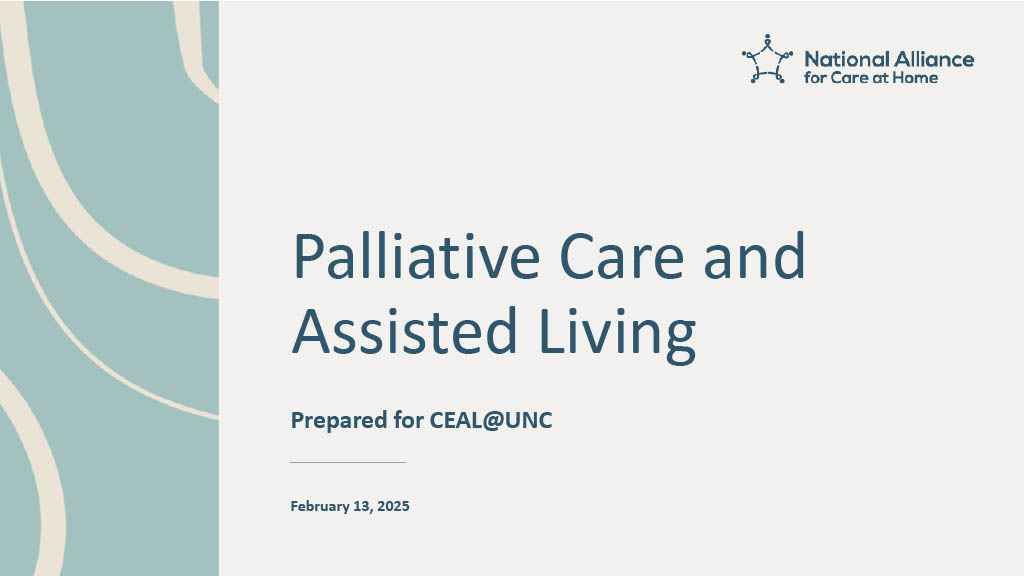
CEAL@UNC Strategic Advisor Presentations
CEAL@UNC regularly invites organizations and individuals committed to advancing well-being in assisted living through practice, research, and policy to present emerging and relevant topics to its Strategic Advisors. View Presentations
CEAL@UNC Strategic Advisor Presentations
CEAL@UNC regularly invites organizations and individuals committed to advancing well-being in assisted living through practice, research, and policy to present emerging and relevant topics to its Strategic Advisors. View Presentations
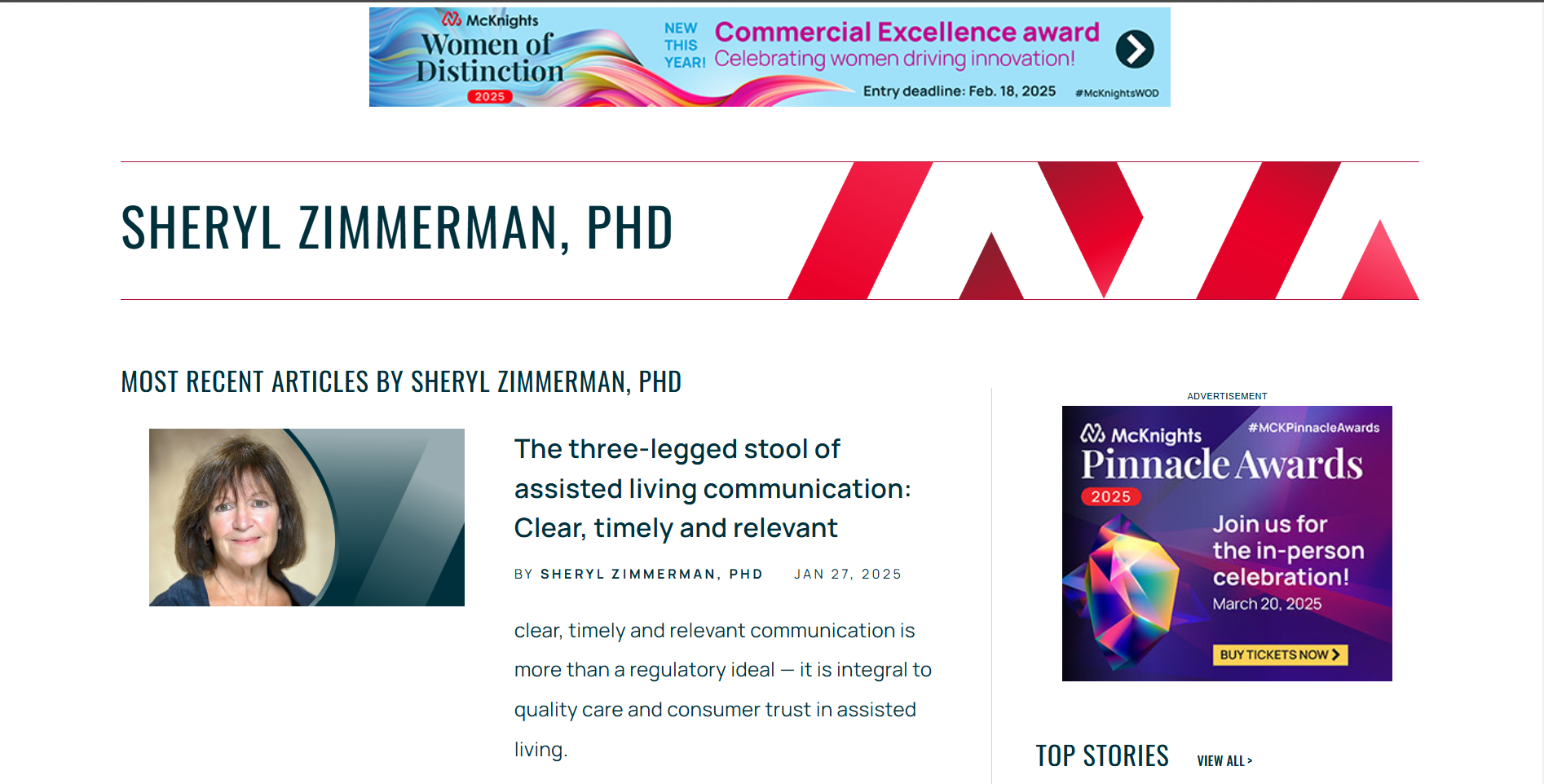
CEAL@UNC Guest Columns: McKnight’s Senior Living
Dr. Sheryl Zimmerman, Executive Director of CEAL@UNC, is a guest columnist for McKnight’s Senior Living. These regularly published articles reflect the perspectives of CEAL@UNC advisors, and address timely topics relevant to the well-being of the people who live and work in assisted living. View Articles
CEAL@UNC Guest Columns: McKnight’s Senior Living
Dr. Sheryl Zimmerman, Executive Director of CEAL@UNC, is a guest columnist for McKnight’s Senior Living. These regularly published articles reflect the perspectives of CEAL@UNC advisors, and address timely topics relevant to the well-being of the people who live and work in assisted living. View Articles
Risk of Hospitalization Among Assisted Living Residents Dually Enrolled in Medicare and Medicaid
Objectives To examine how risk of hospitalization among assisted living (AL) residents differs by dual enrollment in Medicare and Medicaid and by the percent of dually enrolled individuals in an AL community. Design Retrospective cohort study. Setting and Participants We used Medicare data from 2008 to 2018 and a national directory of licensed AL communities […]
Risk of Hospitalization Among Assisted Living Residents Dually Enrolled in Medicare and Medicaid
Objectives To examine how risk of hospitalization among assisted living (AL) residents differs by dual enrollment in Medicare and Medicaid and by the percent of dually enrolled individuals in an AL community. Design Retrospective cohort study. Setting and Participants We used Medicare data from 2008 to 2018 and a national directory of licensed AL communities […]
Transitions to Nursing Homes Among Residents of Assisted Living and Community-Dwelling Home Care Recipients
Objectives To examine transitions to a nursing home among residents of assisted living relative to community-dwelling home care recipients. Design Population-based retrospective cohort study emulating a target trial. Setting and Participants Linked, individual-level health system data were obtained from older adults (≥65 years of age) who made an incident application for a bed in a nursing […]
Transitions to Nursing Homes Among Residents of Assisted Living and Community-Dwelling Home Care Recipients
Objectives To examine transitions to a nursing home among residents of assisted living relative to community-dwelling home care recipients. Design Population-based retrospective cohort study emulating a target trial. Setting and Participants Linked, individual-level health system data were obtained from older adults (≥65 years of age) who made an incident application for a bed in a nursing […]
Association Between Organizational Context and Resident Pain in Assisted Living: A Repeated Cross-Sectional Study
Objectives: Resident pain has been a common quality challenge in congregate care for older adults, and organizational context may explain variations in resident pain beyond resident-level factors. Most studies have focused on nursing homes (NHs), largely neglecting assisted living (AL). AL residents are at similar risk for pain as NH resident, but with AL providing fewer […]
Association Between Organizational Context and Resident Pain in Assisted Living: A Repeated Cross-Sectional Study
Objectives: Resident pain has been a common quality challenge in congregate care for older adults, and organizational context may explain variations in resident pain beyond resident-level factors. Most studies have focused on nursing homes (NHs), largely neglecting assisted living (AL). AL residents are at similar risk for pain as NH resident, but with AL providing fewer […]
Effect of a Digital Two-Dimensional Animation Program on Attitude Toward Walking Aids, Performance, and Fall Avoidance Behaviors among Older Adults in Assisted Living Facilities
The study investigated the impact of a two-dimensional animation program on attitudes towards walking aids, performance, and fall avoidance behaviors among older adults in assisted living facilities. A quasi-experimental pretest-posttest control group study was conducted on 128 older adults aged 60 years and above. The intervention group showed more favorable attitudes towards walking aids, improved […]
Effect of a Digital Two-Dimensional Animation Program on Attitude Toward Walking Aids, Performance, and Fall Avoidance Behaviors among Older Adults in Assisted Living Facilities
The study investigated the impact of a two-dimensional animation program on attitudes towards walking aids, performance, and fall avoidance behaviors among older adults in assisted living facilities. A quasi-experimental pretest-posttest control group study was conducted on 128 older adults aged 60 years and above. The intervention group showed more favorable attitudes towards walking aids, improved […]
Clinical and Sociodemographic Characteristics of New Residents of Assisted Living: A Nested Case-Control Study
Objective To examine transitions to an assisted living facility among community-dwelling older adults who received publicly funded home care services. Design Nested case-control study. Setting and Participants Linked, population-level health system administrative data were obtained from adults aged 65 years and older who received home care services in Ontario, Canada, from April 1, 2018, to December […]
Clinical and Sociodemographic Characteristics of New Residents of Assisted Living: A Nested Case-Control Study
Objective To examine transitions to an assisted living facility among community-dwelling older adults who received publicly funded home care services. Design Nested case-control study. Setting and Participants Linked, population-level health system administrative data were obtained from adults aged 65 years and older who received home care services in Ontario, Canada, from April 1, 2018, to December […]
Factors Associated with Transfer from Assisted Living Facilities to a Nursing Home: National Health Aging Trends Study 2011-2019
Background Residents of assisted living facilities (ALF) transfer to a nursing home when they require a higher level of care, but limited research has examined risk factors for transfer to a nursing home. The aims of this study were to identify (1) baseline factors associated with transfer to a nursing home and (2) time-varying factors […]
Factors Associated with Transfer from Assisted Living Facilities to a Nursing Home: National Health Aging Trends Study 2011-2019
Background Residents of assisted living facilities (ALF) transfer to a nursing home when they require a higher level of care, but limited research has examined risk factors for transfer to a nursing home. The aims of this study were to identify (1) baseline factors associated with transfer to a nursing home and (2) time-varying factors […]
Feasibility of a Novel Lighting System to Reduce Nighttime Falls in Assisted Living Residents With Dementia
Objectives To determine the feasibility of conducting a trial of a novel nighttime lighting system designed to support postural stability in assisted living (AL) residents, and to estimate intervention effectiveness by comparing the incidence of nighttime falls during the novel lighting condition to that in a control condition featuring a standard nightlight. Design Randomized crossover […]
Feasibility of a Novel Lighting System to Reduce Nighttime Falls in Assisted Living Residents With Dementia
Objectives To determine the feasibility of conducting a trial of a novel nighttime lighting system designed to support postural stability in assisted living (AL) residents, and to estimate intervention effectiveness by comparing the incidence of nighttime falls during the novel lighting condition to that in a control condition featuring a standard nightlight. Design Randomized crossover […]
Managers’ Perspectives on their Role in Implementing Fall Prevention Interventions: A Qualitative Interview Study in Norwegian Homecare Services
Introduction: The implementation of fall prevention interventions in homecare services is crucial for reducing falls among older adults and effective leadership could determine success. Norwegian homecare services provide home nursing, rehabilitation, and practical assistance, to residents living in private homes or assisted living facilities. This study aims to explore how managers in Norwegian homecare services […]
Managers’ Perspectives on their Role in Implementing Fall Prevention Interventions: A Qualitative Interview Study in Norwegian Homecare Services
Introduction: The implementation of fall prevention interventions in homecare services is crucial for reducing falls among older adults and effective leadership could determine success. Norwegian homecare services provide home nursing, rehabilitation, and practical assistance, to residents living in private homes or assisted living facilities. This study aims to explore how managers in Norwegian homecare services […]
Admission and Discharge Practices Among Assisted Living Communities: The Role of State Regulations and Organizational Characteristics
Background and Objectives: A better understanding of factors associated with assisted living admission and discharge practices can help identify communities that are more likely to allow residents to age in place. This study examined how state regulations and assisted living organizational characteristics related to community admission and discharge practices for bathing, getting out of bed, […]
Admission and Discharge Practices Among Assisted Living Communities: The Role of State Regulations and Organizational Characteristics
Background and Objectives: A better understanding of factors associated with assisted living admission and discharge practices can help identify communities that are more likely to allow residents to age in place. This study examined how state regulations and assisted living organizational characteristics related to community admission and discharge practices for bathing, getting out of bed, […]
Revolutionizing Patient Surveillance in Assisted Living Facilities: Insights from AUGi Technology Implementation
In the face of escalating non-fatal fall-related expenses and an aging population, innovative solutions in assisted living facilities (ALFs) are imperative. This study evaluates the implementation of a remote-surveillance technology (AUGi) across three diverse ALFs, emphasizing its impact on falls and falls with injury across sites. Utilizing comprehensive data collection, AUGi facilitated an average reduction […]
Revolutionizing Patient Surveillance in Assisted Living Facilities: Insights from AUGi Technology Implementation
In the face of escalating non-fatal fall-related expenses and an aging population, innovative solutions in assisted living facilities (ALFs) are imperative. This study evaluates the implementation of a remote-surveillance technology (AUGi) across three diverse ALFs, emphasizing its impact on falls and falls with injury across sites. Utilizing comprehensive data collection, AUGi facilitated an average reduction […]
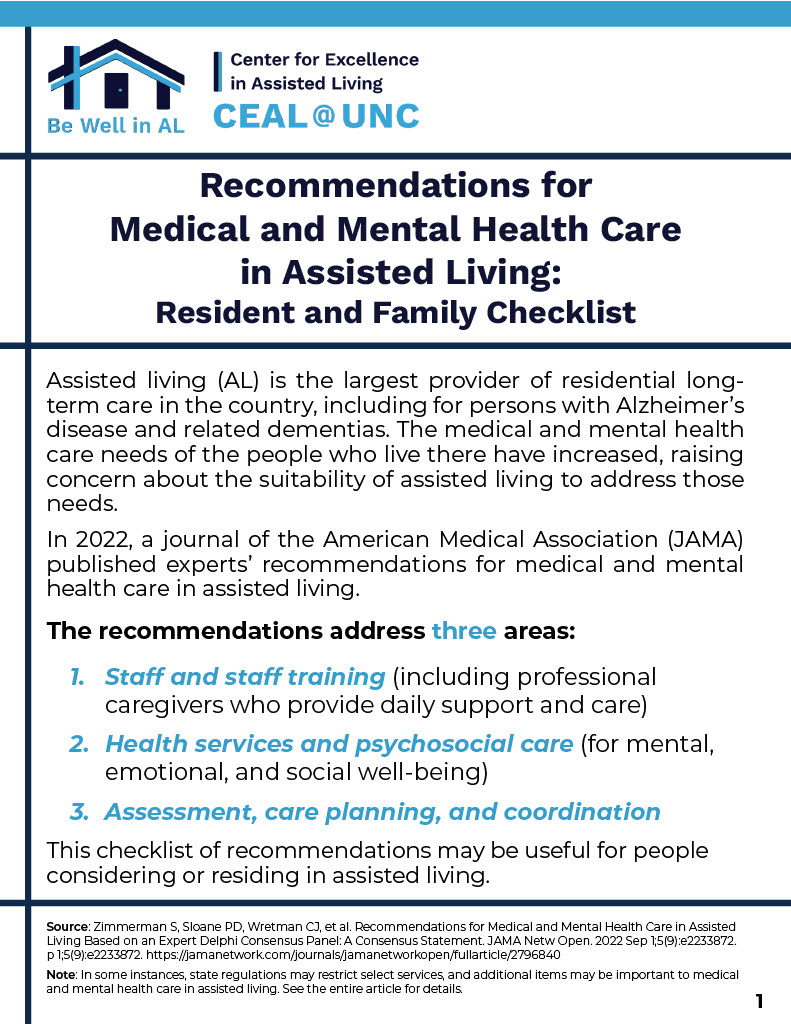
Be Well in AL Recommendations: Resident/Family Checklist
CEAL@UNC recognizes the benefit of ongoing quality improvement in assisted living, including through the implementation of consensus medical and mental health care recommendations disseminated through the Be Well in AL Initiative. This checklist, to be used by residents and their families considering or residing in assisted living, is a helpful tool to understand recommended care […]
Be Well in AL Recommendations: Resident/Family Checklist
CEAL@UNC recognizes the benefit of ongoing quality improvement in assisted living, including through the implementation of consensus medical and mental health care recommendations disseminated through the Be Well in AL Initiative. This checklist, to be used by residents and their families considering or residing in assisted living, is a helpful tool to understand recommended care […]
Know the Resident: Unlocking Value and Positive Outcomes in Assisted Living Nursing
WHAT THIS MEANS FOR YOU: In this editorial, the authors emphasize that addressing social determinants of health in AL communities is crucial for improving residents' well-being and can be accomplished in part through nurse leadership. It presents a framework to address residents’ social needs, focusing on a proactive and holistic approach to care.
Know the Resident: Unlocking Value and Positive Outcomes in Assisted Living Nursing
WHAT THIS MEANS FOR YOU: In this editorial, the authors emphasize that addressing social determinants of health in AL communities is crucial for improving residents’ well-being and can be accomplished in part through nurse leadership. It presents a framework to address residents’ social needs, focusing on a proactive and holistic approach to care.
Bioethics in Gerontology: Developing a Typology of Ethical Issues in Assisted Living
WHAT THIS MEANS FOR YOU: A team of researchers developed a typology of the ethical conflicts that are likely to exist within AL communities. Drawing on data from a 5-year qualitative study in four ALs for validation, this typology aims to help families, staff, and residents identify and understand ethical best practices in AL communities.
Bioethics in Gerontology: Developing a Typology of Ethical Issues in Assisted Living
WHAT THIS MEANS FOR YOU: A team of researchers developed a typology of the ethical conflicts that are likely to exist within AL communities. Drawing on data from a 5-year qualitative study in four ALs for validation, this typology aims to help families, staff, and residents identify and understand ethical best practices in AL communities.
Does Assisted Living Provide Assistance And Promote Living?
WHAT THIS MEANS FOR YOU: AL communities in the United States serve more than 918,000 older adults as of 2018. In this commentary, the authors examined how workforce limitations, the complexity of regulations, consumer needs, and lack of financing contribute to negative consequences for aging in place and well-being. They suggest policy changes in those four areas, such as increased staffing, boosting wages and training, encouraging uniform data reporting, and making community disclosure statements more accessible.
Does Assisted Living Provide Assistance And Promote Living?
WHAT THIS MEANS FOR YOU: AL communities in the United States serve more than 918,000 older adults as of 2018. In this commentary, the authors examined how workforce limitations, the complexity of regulations, consumer needs, and lack of financing contribute to negative consequences for aging in place and well-being. They suggest policy changes in those four areas, such as increased staffing, boosting wages and training, encouraging uniform data reporting, and making community disclosure statements more accessible.
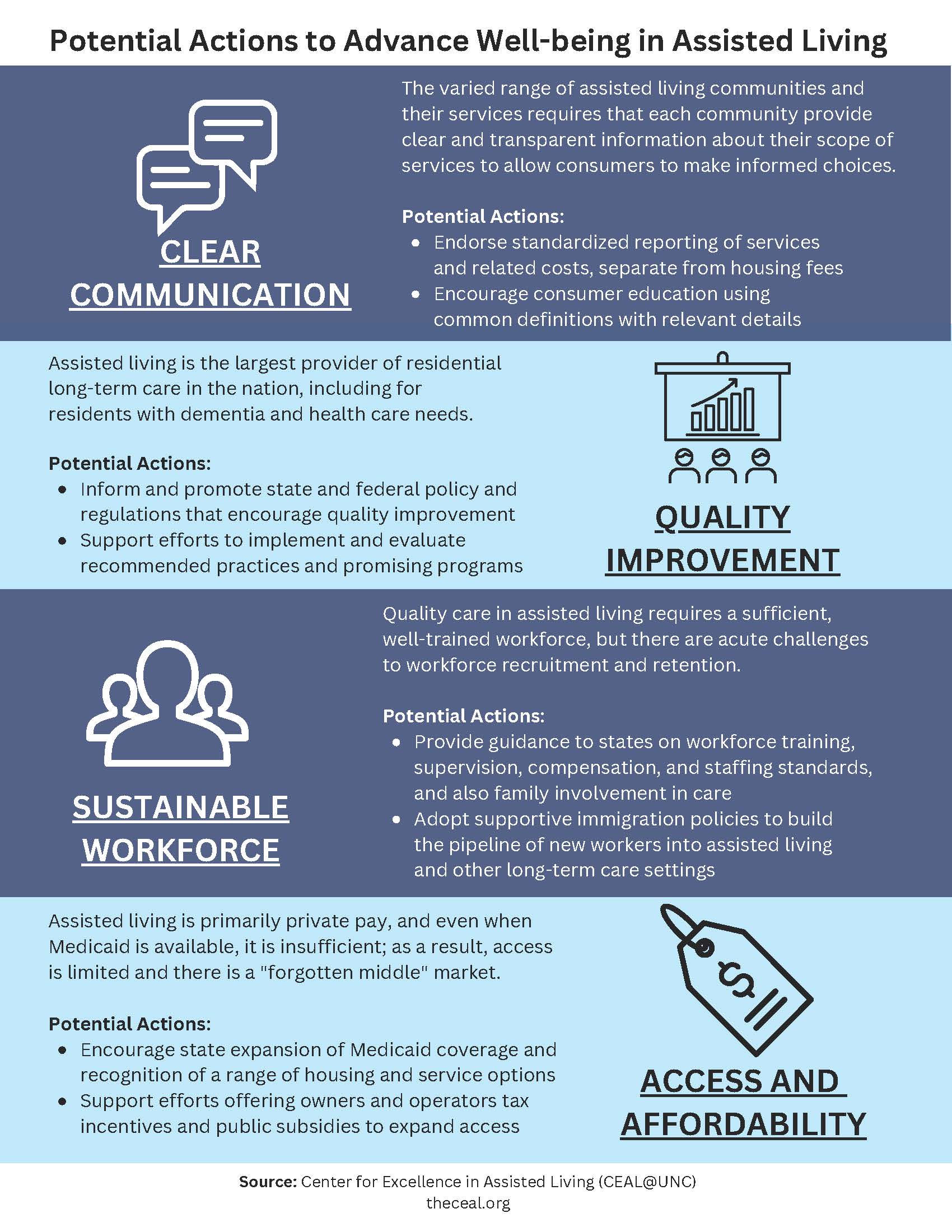
Potential Actions to Advance Well-being in Assisted Living
CEAL@UNC recognizes the benefit of ongoing quality improvement in assisted living. Numerous feasible solutions have been suggested that may improve care and outcomes in assisted living, including those in this information sheet. Feel free to utilize and distribute this information sheet among your networks to advance the well-being of the people who live and work […]
Potential Actions to Advance Well-being in Assisted Living
CEAL@UNC recognizes the benefit of ongoing quality improvement in assisted living. Numerous feasible solutions have been suggested that may improve care and outcomes in assisted living, including those in this information sheet. Feel free to utilize and distribute this information sheet among your networks to advance the well-being of the people who live and work […]
A Step Toward Better Care: Understanding What Caregivers and Residents in Assisted Living Facilities Value in Health Monitoring Systems
WHAT THIS MEANS FOR YOU: Expert interviews, cognitive walkthroughs, and semi-structured interviews were conducted with 7 caregivers and 5 residents from an AL community to understand the role that health monitoring technology plays in their work and lives. Monitoring technology was viewed as a way to reduce caregivers' workload and improve team communication. Residents were open to using the technology, but protecting their privacy and autonomy was a concern for its implementation.
A Step Toward Better Care: Understanding What Caregivers and Residents in Assisted Living Facilities Value in Health Monitoring Systems
WHAT THIS MEANS FOR YOU: Expert interviews, cognitive walkthroughs, and semi-structured interviews were conducted with 7 caregivers and 5 residents from an AL community to understand the role that health monitoring technology plays in their work and lives. Monitoring technology was viewed as a way to reduce caregivers’ workload and improve team communication. Residents were open to using the technology, but protecting their privacy and autonomy was a concern for its implementation.
Quality of Life in Assisted Living Facilities for Seniors: A Descriptive Exploratory Study
WHAT THIS MEANS FOR YOU: Seventeen residents in two AL communities were interviewed about their perceived quality of life. Their perspectives reflected an emphasis on the physical environment, social environment, and home-like atmosphere. The two major indicators of quality of life in the AL community were the resident’s ability to adapt to change and the community’s ability to meet residents’ diverse needs.
Quality of Life in Assisted Living Facilities for Seniors: A Descriptive Exploratory Study
WHAT THIS MEANS FOR YOU: Seventeen residents in two AL communities were interviewed about their perceived quality of life. Their perspectives reflected an emphasis on the physical environment, social environment, and home-like atmosphere. The two major indicators of quality of life in the AL community were the resident’s ability to adapt to change and the community’s ability to meet residents’ diverse needs.
Worse Quality at For-Profit Assisted Living Facilities in Non-Urban Minnesota
WHAT THIS MEANS FOR YOU: This study examined the results of licensure surveys for 292 AL communities in non-urban Minnesota between 2021 and 2023. All AL communities received at least one citation, with an average of 15 citations. Citations were most commonly related to meals (e.g., not providing nutritious meals) and fire protection (e.g., safety and evacuation plans). The average number of citations and resulting fines were higher in for-profit communities than in non-profit/government communities.
Worse Quality at For-Profit Assisted Living Facilities in Non-Urban Minnesota
WHAT THIS MEANS FOR YOU: This study examined the results of licensure surveys for 292 AL communities in non-urban Minnesota between 2021 and 2023. All AL communities received at least one citation, with an average of 15 citations. Citations were most commonly related to meals (e.g., not providing nutritious meals) and fire protection (e.g., safety and evacuation plans). The average number of citations and resulting fines were higher in for-profit communities than in non-profit/government communities.
A Collaborative Approach to Improving Care Outcomes for Residents in Assisted Living
WHAT THIS MEANS FOR YOU: A longitudinal study of 50 residents and 119 care partners in 8 AL communities in Georgia over 2 years examined the concept of a “care convoy” (a dynamic network of formal and informal care partners) for AL residents. This model was supported by formal and informal interviewing, participant observation, and record review. The model is recommended for use by physicians and other healthcare providers to assist them in supporting the needs and goals of the residents and their care convoys, which is theorized to achieve better care outcomes.
A Collaborative Approach to Improving Care Outcomes for Residents in Assisted Living
WHAT THIS MEANS FOR YOU: A longitudinal study of 50 residents and 119 care partners in 8 AL communities in Georgia over 2 years examined the concept of a “care convoy” (a dynamic network of formal and informal care partners) for AL residents. This model was supported by formal and informal interviewing, participant observation, and record review. The model is recommended for use by physicians and other healthcare providers to assist them in supporting the needs and goals of the residents and their care convoys, which is theorized to achieve better care outcomes.
Measuring Older Adults’ Wellbeing When Transitioning into Assisted Living Facilities: A Confirmatory Factor Analysis of the Mueller Assessment of Transition (MAT)
WHAT THIS MEANS FOR YOU: A study of the Mueller Assessment of Transition (MAT) tool in108 older adults in the U.S. who were transitioning into assisted living communities found that the MAT effectively measured wellbeing impact across regions and was internally consistent. Results suggests that the MAT could be a valuable tool for assessing the wellbeing of older adults during the transition to assisted living.
Measuring Older Adults’ Wellbeing When Transitioning into Assisted Living Facilities: A Confirmatory Factor Analysis of the Mueller Assessment of Transition (MAT)
WHAT THIS MEANS FOR YOU: A study of the Mueller Assessment of Transition (MAT) tool in108 older adults in the U.S. who were transitioning into assisted living communities found that the MAT effectively measured wellbeing impact across regions and was internally consistent. Results suggests that the MAT could be a valuable tool for assessing the wellbeing of older adults during the transition to assisted living.
Older Adults’ Experiences of Participation in Daily Activities in Swedish Assisted Living
WHAT THIS MEANS FOR YOU: Eleven older adults interviewed in two assisted living communities in Sweden reported their feelings regarding participation and decision-making in daily activities, such as routine personal and medical care. In a qualitative analysis, residents actively participating in these activities reported they led to feelings of happiness, connection, involvement and safety. However, the organization and work environment dictated the ability of care and nursing staff to involve residents in daily activities, a challenge of which the residents were also aware.
Older Adults’ Experiences of Participation in Daily Activities in Swedish Assisted Living
WHAT THIS MEANS FOR YOU: Eleven older adults interviewed in two assisted living communities in Sweden reported their feelings regarding participation and decision-making in daily activities, such as routine personal and medical care. In a qualitative analysis, residents actively participating in these activities reported they led to feelings of happiness, connection, involvement and safety. However, the organization and work environment dictated the ability of care and nursing staff to involve residents in daily activities, a challenge of which the residents were also aware.


